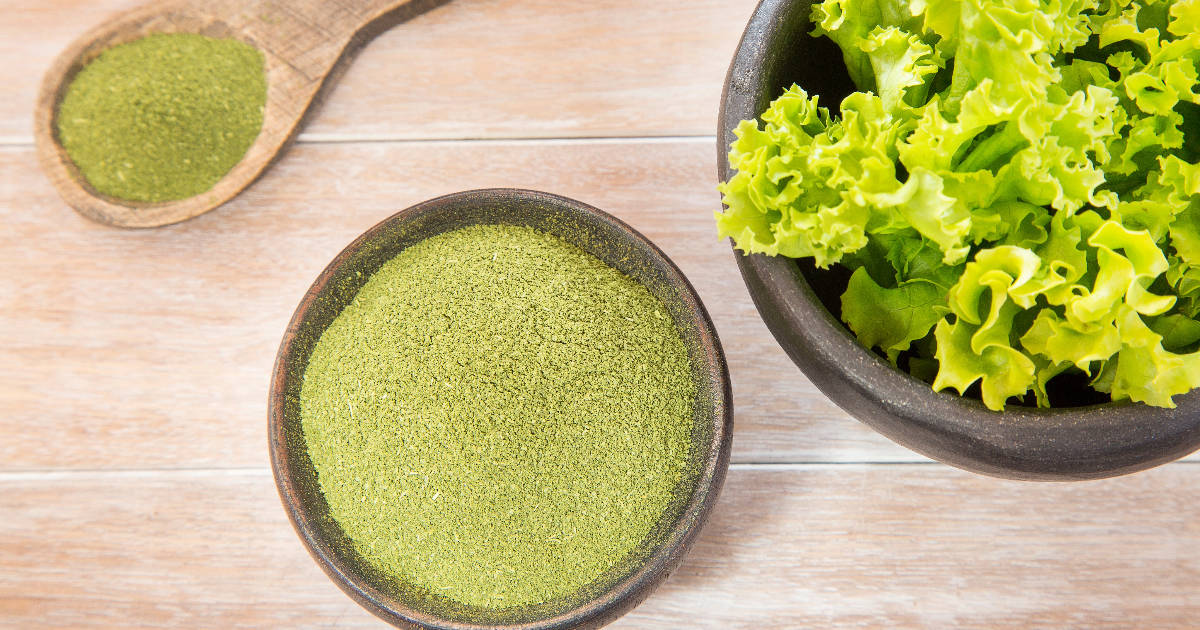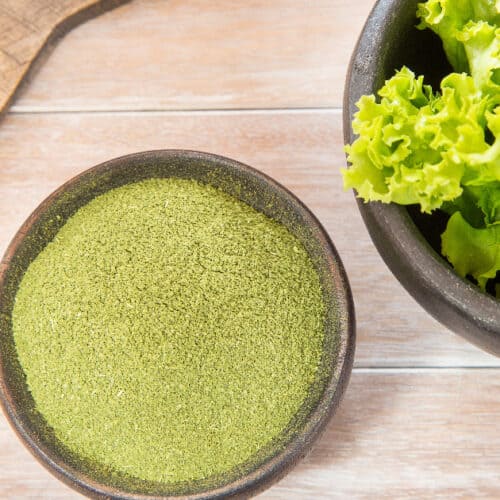Kale powder has become an increasingly popular way to preserve and consume this leafy green superfood. Making your own kale powder at home is simple, requiring just a few basic steps: washing and drying the kale, blending it into a fine powder, and storing for later use.

The process condenses pounds of fresh kale down into a concentrated, shelf-stable powder that lasts for months. This allows you to benefit from kale's incredible nutrition all year long. Kale powder can be seamlessly added to smoothies, baked goods, soups, sauces, and more.
Why Choose Kale? The Incredible Health Benefits
Kale has rightfully earned its place on the pedestal as a premier superfood. This dark, leafy green is packed with vitamins, minerals, and disease-fighting phytochemicals.
Consuming kale regularly has been tied to numerous health benefits:
- Stronger immune system
- Healthy inflammation response
- Lower cholesterol
- Eye and skin health
- Reduced risk of chronic disease
- Potential anti-cancer effects
The U.S. Department of Agriculture recommends 21⁄2 cups of vegetables daily, with dark greens like kale being particularly important.
However, hitting this target can be challenging. This is where kale powder comes in – allowing you to conveniently add nutrients from over 2 cups of kale into a single smoothie or dish.
Let's look closer at why kale powder can be preferrable over fresh kale at times:
- Condensed nutrition: Just 1-2 teaspoons of kale powder provides the equivalent nutrients of 1 cup raw kale. This highly concentrated form makes it easy to add a mega-dose of nutrition.
- Invisible addition: Kale powder blends smoothly into foods and beverages with zero effect on texture or taste. This makes it perfect for picky eaters or dishes where you want nutrition without altering flavor.
- Longer shelf life: Fresh kale lasts about 5 days in the fridge. Meanwhile, kale powder stored in an airtight container retains nutrients for 6-12 months. No more fretting over wilted greens!
Now that you know the benefits, let's get into the simple process of making your own kale powder at home.
Step 1: Wash and Dry Fresh Kale Leaves
You'll want to start with the freshest kale possible, whether from your garden or the grocery store. Look for crisp, deeply colored leaves with no yellowing or sliminess.
Rinse the kale thoroughly under cool water to remove any dirt. You'll also want to trim off any thick stems, as these can be tough and fibrous.
Next, use a salad spinner or blot leaves dry with paper towels or clean dishcloths. Getting rid of excess moisture is crucial, as any remaining water content could cause mold growth during dehydrating or storage.
Make sure no water droplets remain on the surface of leaves before moving to the next step.
Key Takeaway: Always wash produce thoroughly before dehydrating to avoid contamination issues.
Step 2: Dehydrate the Kale
In order to make kale powder, you'll need to remove almost all moisture content from the fresh leaves. This transforms their texture from moist and flexible to dry and brittle – perfect for grinding into powder.
You have two options when it comes to dehydrating kale at home:
Option 1: Use a Dehydrator
A food dehydrator offers the fastest, most foolproof way to dehydrate greens. Food dehydrators use a controlled warm air flow and timed drying cycles to safely remove moisture. Most models have stackable trays, allowing you to dehydrate large batches simultaneously.
To dehydrate kale:
- Arrange washed kale in a single, loose layer across dehydrator trays. Make sure leaves aren’t overlapping or bunched together.
- Set the temperature to 125°F.
- Let kale dehydrate for 6-8 hours. Check it occasionally; drying time can vary based on humidity levels and the amount of kale used.
- Kale is ready when fully crisp and brittle with no remaining moisture or pliability.
Option 2: Use Your Oven
If you don't own a food dehydrator, don't worry – your oven can work too! While it doesn't offer quite as precise control, you can absolutely DIY kale chips at home.
To dehydrate kale in the oven:
- Preheat your oven to its absolute lowest temperature, usually around 170°F.
- Arrange washed, dried kale in a single layer on top of baking sheets. Using parchment paper can prevent sticking.
- Bake kale for 1-2 hours initially. Then, prop the oven door slightly ajar with a balled-up piece of foil. This allows additional moisture to escape.
- Continue drying for another 2-3 hours, checking and rotating trays periodically.
- Total oven drying time is usually 4-6 hours. Kale should be completely crisp and crumble easily in your fingers when ready.
No matter which appliance you use, the most crucial step is ensuring kale is fully dehydrated before moving to grinding. Any remaining moisture invites trouble.
Step 3: Grind Kale into Powder
Once your kale leaves are crispy and bone-dry, you’re ready to grind them into a fine powder. This last transformation from flakes to dust allows the kale to dissolve seamlessly into foods and beverages.
You’ll want to use a high-powered blender or food processor for this step. Lower-powered blenders may struggle to get kale down to a fine consistency. Stand mixers usually aren’t ideal either.
Here are your blending best practices:
- Break dried kale leaves into smaller pieces by hand first to allow for easier powdering.
- Work in small batches, filling your blender only 2⁄3 full at once. Overcrowding makes it hard for blades to reach all contents.
- Start by pulsing to break kale down further. Then switch to continuously blending once smaller.
- Use a rubber spatula to frequently scrape down powder sticking to blender sides back into the blades’ path.
- Keep blending in intervals until kale resembles a smooth, bright green powder. There should be no remaining gritty flecks or green confetti-like pieces visible.
- Avoid overheating your blender motor during this process by giving it breaks as needed. Powdering leathery kale leaves takes some work!
When done, you’ll have a jar full of concentrated kale nutrition ready to boost everything from baked goods to salad dressings.
Creative Ways to Use Your Kale Powder
Now comes the fun part: using your DIY kale powder to sneak extra nutrition into your diet!
thanks to its mild, plant-based flavor and green color, kale powder seamlessly disappears into just about anything. You’ll be shocked at the endless ways you can incorporate it.
Here are some of my favorite tricks:
- Smoothies: Add 1-2 teaspoons per smoothie for the equivalent of 1+ cups raw kale. Berries, chocolate, or peanut butter easily mask any flavors.
- Juices and lemonades: Stir a teaspoon into fruit or veggie juices. Citrus flavors especially cover up green undertones.
- Baked goods: Toss a tablespoon per batch into muffins, breads, waffles, or pancakes. The powder dissolves leaving zero texture or taste.
- Healthy desserts: Mix some into nice cream, chia pudding, bliss balls, or homemade protein bars for bonus nutrition.
- Soups and chilis: Whisk in kale powder when serving any creamy blended soup. Heartier chilis can handle a few teaspoons too.
- Casseroles and pasta: Add kale powder while assembling lasagnas, mac and cheese, enchiladas, pasta bakes, risottos, and more.
- Eggs: Sprinkle onto omelets, frittatas, scrambles, and bakes just prior to serving. Quiches love extra veggie goodness mixed into batter as well.
- Dressings and dips: Blend into green goddess dressing, basil dip, hummus, ranch dressing, salsa verde, guacamole, and pesto.
- Sauces: Mix into any tomato sauce, alfredo sauce, cheese sauce, or gravy starting with 1⁄4 teaspoon kale powder per cup. Adjust to taste!

Kale Powder Recipe
Ingredients
- 2 pounds fresh kale, washed, dried, and chopped
- Food dehydrator or oven
- Blender or food processor
Instructions
- Wash kale thoroughly and ensure all stems are removed. Pat leaf surfaces completely dry.
- Dehydrate kale using a dehydrator at 125oF for 6-8 hours or a low oven at 170oF for 4-6 hours. Leaves should be crisp and crumbly.
- Place dried kale into a blender or food processor. Pulse, scraping container sides often, until a fine powder forms.
- Store powder in a sealed glass jar and use within 6-12 months by folding into smoothies, baked goods, dressings, and dips for a nutritional boost!
FAQs
What's the best kale variety for making powder?
Curly green kales like Scotch or Siberian work wonderfully, thanks to their ruffled surface area that dries quickly. Purple kales like Redbor or Red Russian lend fun color! The choice is yours.
Can you use other greens like spinach or chard?
Absolutely! Follow the exact same process to make spinach powder, chard powder, collard powder, beet green powder, or powders from any other hardy cooking green. Get creative with your garden goodies!
How long does kale powder last?
Properly stored in an airtight glass jar or container, kale powder will retain optimum potency and nutrition for 6-12 months at room temperature. If extending past a year, consider refrigerating or freezing instead.
Conclusion
Whipping up your own kale powder only requires a few simple steps, making gallons of fresh kale manageable for long term use. Harnessing the power of this leafy green superfood is now easier than ever.
Be sure to store your kale powder in an airtight container in a cool, dark space to retain maximum nutrients. Over the next 6-12 months, get creative with all the ways you can add it into your daily diet! Smoothies, baked goods, soups, sauces – the possibilities are truly endless.

